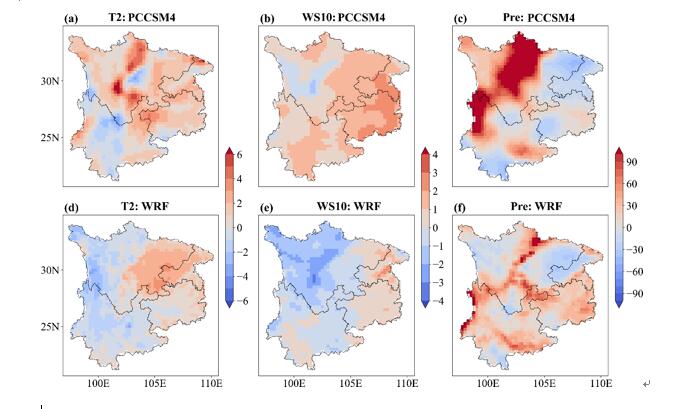联系我们
竺可桢-南森国际研究中心
邮 箱:nzc_iap@mail.iap.ac.cn
邮 编:100029
地 址:北京市朝阳区德胜门外祁家豁子华严里40号 竺南中心

科研进展
Research Progress我国西南地区高分辨率动力降尺度预测系统:系统设计及性能评估
Developing a Climate Prediction System over Southwest China Using the 8-km Weather Research and Forecasting (WRF) Model: System Design, Model Calibration, and Performance Evaluation
[2022-09-24]
【中文介绍】
针对西南地区夏季气候,利用PCCSM4驱动WRF模式,构建了高分辨率的动力降尺度预测系统。该系统包含12个集合成员,在西南地区的模式水平分辨率为8km。在对模式下垫面资料订正及系统的参数化方案遴选后,开展了1981-2020年的回报模拟。模拟结果显示,高分辨率动力降尺度模拟可以显著改进对地表气温、风场和降水的预测技巧(图1)。在气温和极端气温的年际变率预测方面,动力降尺度预测系统ACC更高,相对PCCSM4也有改进。因此,开展我国西南地形复杂地区的高分辨率动力降尺度预测有其潜在的优势。
【英文介绍】
A high-resolution, short-term climate prediction system for summer (June-July-August) climate over Southwest China has been developed using the Weather Research and Forecasting (WRF) model nested with a global climate prediction system (PCCSM4). The system includes 12 ensemble members generated by PCCSM4 with different initial conditions, and the finest horizontal resolution of WRF is 8 km. This study evaluates the ability of the WRF model to predict summer climate over Southwest China, focusing on the system design, model tuning and evaluation of baseline model performance. Sensitivity simulations are firstly conducted to provide the optimal model configuration, and the model performance is evaluated against available observational data using reforecast simulations for 1981-2020. When compared to PCCSM4, the WRF model shows major improvements in predicting the spatial distribution of major variables such as 2-m temperature, 10-m wind speed and precipitation. WRF also shows better skill in predicting inter-annual temperature variability and extreme temperature events, with higher anomaly correlation coefficients. However, large model biases remain in seasonal precipitation anomaly predictions. Overall, this study highlights the potential advantages of using the high-resolution WRF model to predict summer climate conditions over Southwest China.
【关键图表】

图1 WRF对主要气象指标的回报偏差及与PCCSM4的比较
Fig. 1. Spatial distribution of summer mean biases of PCCSM4 (a-c) and WRF (d-f) model for: 2-m temperature (a, d, units: ℃), 10-m wind speed (b, e, units: m/s), (c) precipitation (c, f, units: %) relative to CN05.1.
【引用格式】
Yu,
Entao, Jiehua Ma, and Jianqi Sun. Developing a Climate Prediction System over
Southwest China Using the 8-km Weather Research and Forecasting (WRF) Model:
System Design, Model Calibration, and Performance Evaluation, Weather and Forecasting.
37, 9 (2022): 1703-1719.